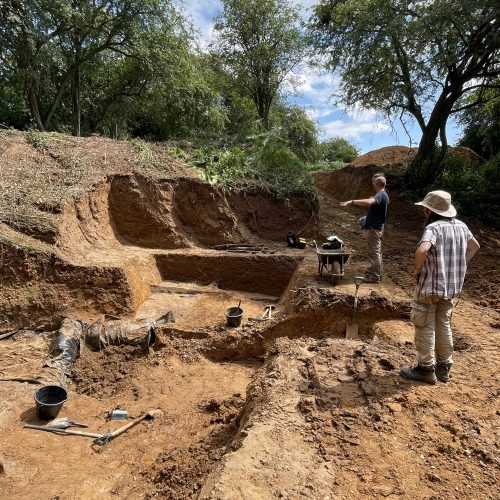There are many Palaeolithic sites in the Breckland that have been the subject of collecting and research, some of them for over a hundred years, and the region has played an important part in the development of Palaeolithic archaeology as a discipline (Davis et al., 2017 [PDF]). This also means that identifying a site that has received rather less attention from archaeologists and geologists is something of a challenge. One such example is Devereux’s Pit in the parish of Icklingham, despite, or perhaps because of, its proximity to the well-known and internationally important Palaeolithic site of Beeches Pit, less than a kilometre away. The site, also known as Icklingham Brick Pit, is a former clay pit between the Suffolk villages of Icklingham and West Stow. The clay pit and adjacent brickyard were operated by William Devereux during the second half of the 19th Century. It was active at the time of the 1st edition Ordnance Survey mapping in 1882 but had ceased to operate by 1903 when the 1st revision mapping was completed.

The site is described by Skertchly, an officer of the Geological Survey (in Whitaker et al. 1891), who notes:
“At the brickyard about a mile E.S.E. of Icklingham All Saints Church, beneath the gravelly soil, dirty loess-like loam is worked to the depth of 15 feet. It dips westward at an angle of about 2°, and in places contains freshwater shells, many fragmentary. Bulimus is the most common genus, Pupa is frequent [no freshwater genus is named.—W. W.] I have also found seeds of plants. No implements have yet (? 1877) been found; but I picked up a small flake, from a fresh piece of talus, that looked as though it had fallen from the loam. Bones and deer-horns have been found, but were buried up by the workmen.” (Whitaker et al. 1891:79).
Devereux’s Pit was also visited in the 1930s by T.T. Paterson as part of his study of the geology of the Breckland.
Despite the potential demonstrated by these early records, no major work was undertaken at the site until the 1990s. In 1997 and 1998, a team led by David Bridgland (Durham University) and Simon Lewis undertook some small-scale geological fieldwork at the site (Lewis 1998). Three sections were excavated and auger holes were sunk. The sections showed fairly consistent sequences of approximately 3 m of brown clays, silts and sands (the ‘brickearth’) overlying at least 3 m of grey clayey sands and silts. Shell fragments were identified at various depths and six molluscan species were identified by Richard Preece. These, along with ostracods and chara, are aquatic species indicative of a temperate climate.
Three artefacts were recovered, all flint flakes produced by direct hard hammer percussion, with one subsequently retouched to form a scraper (illustrated in Lewis, 1998). The condition and technology of the scraper strongly suggest it is Lower Palaeolithic.
Following this work, Devereux’s Pit was again overlooked as other Breckland sites became the focus of attention, so its archaeological potential remained to be demonstrated. The Breckland Palaeolithic Project (2016-19) conducted fieldwork at the site to demonstrate the presence of Lower Palaeolithic artefacts in undisturbed Pleistocene deposits and also to gain a better understanding of the sediments and to obtain further environmental information to help assess its potential on this front. The fieldwork, conducted over 16 days between November 2016 and April 2018, consisted of excavation of geological sections and archaeological test pits, boreholes and a ground penetrating radar (GPR) survey. The work confirmed the presence of a Lower Palaeolithic assemblage at the site and also some indications of burning including heated flints.
Following completion of the Breckland Palaeolithic Project, additional funding was obtained by PAB project researcher Dr Rob Davis to continue the work at Devereux’s Pit. Although no fieldwork was possible in 2020, this phase of work finally got underway in July 2021. A three week excavation has extended the area that is available for archaeological excavation and also carried out additional borehole work to establish the geometry of the deposits within the old pit. Initial indications from this fieldwork which, at the time of writing, is in its first week, are encouraging. Like the nearby site at Barnham, the 19th Century clay extraction has removed a lot of the important deposits. However, following clearing of spoil from an area adjacent to a previously dug section, undisturbed sediments that can be excavated have been identified and it is hoped that this will add to the small assemblage of around one hundred artefacts from the site. Fourteen boreholes have been drilled and we are beginning to get a better understanding of the complex stratigraphy. As in previous investigations, shelly sediments have been found and these will be processed to obtain environmental information and they may also be useful for dating purposes. It is becoming clear that the current work at Devereux’s Pit has the potential to add another site to the Breckland Lower Palaeolithic story.
